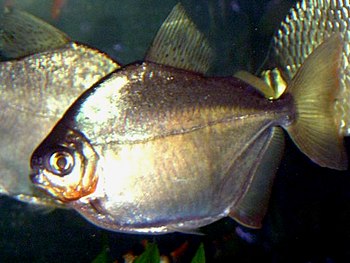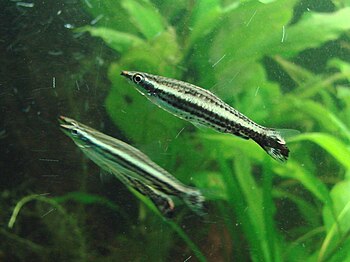If you have a community fish tank or are interested in having one, the silver dollar fish is the perfect fish to fit in with the others. Ideally, having four or five of these fish will keep them quite happy as they like to socialize with one another. Although they are a relative of the piranha, this type of fish is entirely friendly.
 |
| Silver Dollar (Metynnis argenteus). (Photo credit: Wikipedia) |
A lot of space is needed for silver dollar fish so if you were thinking of having a school of them, you would need a tank no smaller than a 50-gallon. If your silver dollar fish was silver dollar size when you bought him, you might be surprised when he grows to his adult five to six inches. He will look extra large too because these fish are as wide as they are tall.
The silver dollar fish is an herbivore, meaning they eat plants. Keep that in mind should you have any live plants in your aquarium. They won't be there long after the arrival of your fish. They eat fish flakes, but if you want to keep these fish really healthy you need to vary their diets with lettuce and other live foods.
In the wild, the silver dollar fish lives in tropical waters, all around South America, and especially in the Amazon River Basin. In the tank, they prefer to have soft water that has a pH of 6.0 to 7.5. If they are in a tank with lots of other fish, they will live in the middle area. They need a nitrate level below 50 ppm. You will need to measure the nitrate level regularly. In lieu of live plants the nitrate level can be aided by letting a little algae grow in the corners of the tank.
With silver dollar fish, especially a school of them, you will want to be sure to keep the cover on your tank. They will leap out of the tank should they get scared of something. You also need to make hiding places for them with lots of rocks and driftwood. When you first get the fish, don't be surprised if they hide a lot. Once they get used to the new environment and know that you are the person with the food, they will get a lot friendlier.
Silver dollar fish will breed in the home aquarium if the conditions are right. They like the temperature of the water to be between 81 and 90 degrees. It only takes around four days for the eggs to hatch and within a week the little guys will be swimming around. You will know they are ready to mate when the female gets two black sports near her side gills and the red on the fins turns black.
Silver dollar fish are one of the most popular aquarium fish. They are very active in the tank and are fun to watch.
To read about pruning cherry trees, silver dollar plant and other information, visit the Gardening Central site. Article Source: EzineArticles |


